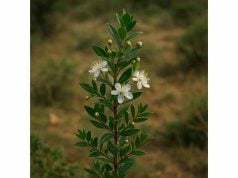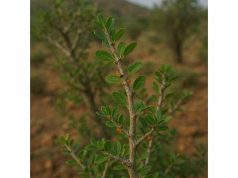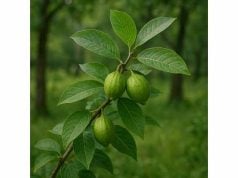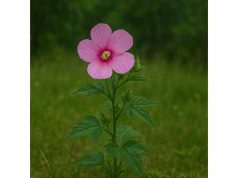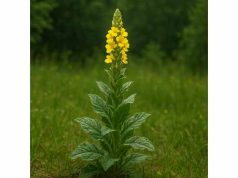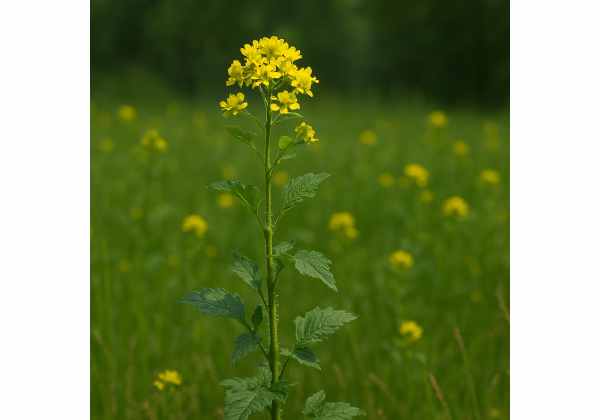
Mustard is a versatile herb celebrated for its robust flavor and impressive health properties. Known for its pungent seeds and nutrient-rich greens, mustard offers a wealth of benefits ranging from digestive aid and cardiovascular support to potent antioxidant and anti-inflammatory actions. Rich in glucosinolates, isothiocyanates, vitamins, and minerals, this herb has been a staple in culinary traditions and natural medicine for centuries. Its active compounds not only contribute to its unique taste but also support detoxification and metabolic health. This comprehensive guide explores mustard’s botanical characteristics, detailed phytochemical profile, extensive health benefits, diverse applications, and the scientific research underpinning its uses.
Table of Contents
- Plant Profile and Identification
- Phytochemical Spectrum and Active Constituents
- Health Advantages and Core Attributes
- Practical Applications and Safety Guidelines
- Research Insights and Notable Study Outcomes
- Frequently Asked Questions
Plant Profile and Identification
Mustard is a member of the Brassicaceae family and includes several species such as Sinapis alba (white mustard), Brassica nigra (black mustard), and Brassica juncea (brown or Indian mustard). These annual or biennial plants are cultivated worldwide for their seeds and leafy greens. Typically, mustard plants grow between 60 and 120 centimeters in height, exhibiting slender stems with lobed, bright green leaves that have a slightly serrated margin. The seeds, small and round, are usually yellow, brown, or black depending on the species and are known for their sharp, tangy flavor.
Taxonomy and Botanical Features
The botanical classification of mustard places it within the order Brassicales, renowned for its pungent and bioactive compounds. The flowers of mustard are typically yellow, small, and arranged in clusters. These blossoms are not only visually appealing but also attract various pollinators, contributing to the reproductive success of the plant. After pollination, the plant produces seed pods (siliques) that split open to disperse seeds, ensuring the propagation of the species.
Growth Conditions and Natural Habitat
Mustard thrives in temperate climates and adapts well to a variety of soil types, though it prefers well-drained, loamy soils with a neutral pH. It grows best in full sunlight and tolerates periods of drought, making it a resilient crop in many agricultural systems. Historically, mustard has been cultivated in regions of Europe, Asia, and North America, where it plays an essential role both as a food crop and a medicinal herb. Its ability to grow in poor soils and its fast maturity rate make it an economical choice for farmers, contributing to its widespread popularity.
Historical and Cultural Significance
Throughout history, mustard has been used both as a culinary spice and a medicinal remedy. Ancient civilizations in Egypt, Greece, and Rome valued mustard for its stimulating and preservative qualities. In traditional medicine, mustard seeds were often used to promote digestion, relieve muscle aches, and improve circulation. Over the centuries, mustard has evolved from a wild plant into a cultivated crop, its seeds now a common ingredient in sauces, dressings, and condiments around the globe. This deep-rooted historical legacy underscores the enduring significance of mustard in both gastronomic and therapeutic traditions.
Modern Cultivation and Ecological Benefits
Today, mustard is cultivated on a large scale in many countries, contributing not only to the culinary arts but also to sustainable agriculture. Mustard plants are used as cover crops, improving soil structure and suppressing weeds naturally. Their deep root systems help in reducing soil erosion and enhancing nutrient recycling. Moreover, mustard greens are a rich source of vitamins and minerals, making them a popular choice in health-conscious diets. The integration of mustard into crop rotation systems has further cemented its role in promoting ecological balance and soil health.
In summary, the botanical profile of mustard—with its diverse species, distinctive morphology, and adaptability—highlights its importance as both a food source and a medicinal herb. Its robust growth, historical relevance, and ecological benefits make mustard a unique and valuable plant with widespread applications in modern agriculture and herbal medicine.
Phytochemical Spectrum and Active Constituents
The health-promoting properties of mustard are largely due to its rich phytochemical composition. The seeds, leaves, and even the stems contain a variety of bioactive compounds that contribute to its pungent flavor and therapeutic benefits. Below is an exploration of the key active constituents found in mustard:
- Glucosinolates
Mustard seeds are particularly rich in glucosinolates, sulfur-containing compounds that play a critical role in the plant’s defense mechanism. When the seeds are crushed or chewed, an enzyme called myrosinase converts glucosinolates into isothiocyanates. These compounds have been extensively studied for their anti-carcinogenic, antimicrobial, and anti-inflammatory properties. Isothiocyanates, such as allyl isothiocyanate, contribute to mustard’s characteristic heat and pungency. - Isothiocyanates
Derived from the hydrolysis of glucosinolates, isothiocyanates are the primary compounds responsible for mustard’s sharp flavor and health benefits. These molecules have been shown to support detoxification processes in the liver, stimulate antioxidant pathways, and inhibit the growth of cancer cells. Their potent bioactivity is a major reason why mustard is valued in both culinary and medicinal contexts. - Flavonoids
Mustard greens are a rich source of flavonoids, including quercetin, kaempferol, and isorhamnetin. These polyphenolic compounds exhibit strong antioxidant and anti-inflammatory properties. Flavonoids help neutralize free radicals, protect cellular integrity, and support vascular health. Their presence contributes to the herb’s overall ability to reduce oxidative stress and lower the risk of chronic diseases. - Phenolic Acids
Phenolic acids, such as ferulic acid and sinapic acid, are another group of antioxidants present in mustard. These compounds not only contribute to the flavor profile of mustard but also enhance its ability to combat inflammation and protect against environmental stressors. Their synergistic action with flavonoids further strengthens mustard’s therapeutic potential. - Essential Oils
The essential oil fraction of mustard, particularly in mustard seeds, contains volatile compounds like allyl isothiocyanate, which are responsible for the herb’s intense aroma and heat. These oils have antimicrobial and anti-inflammatory properties and are widely used in both culinary preparations and natural remedies. They also contribute to the digestive-stimulant effects of mustard. - Vitamins and Minerals
Mustard greens are exceptionally nutrient-dense, containing high levels of vitamins A, C, and K, as well as folate and several B vitamins. Additionally, they are a good source of essential minerals such as calcium, magnesium, potassium, and iron. These nutrients support various bodily functions, including immune response, bone health, and energy metabolism, making mustard an excellent dietary addition. - Dietary Fiber
The high fiber content in mustard greens aids in digestion, promotes a healthy gut microbiome, and helps regulate blood sugar levels. Fiber not only contributes to satiety but also supports cardiovascular health by helping to lower cholesterol levels and improve overall metabolic function. - Omega Fatty Acids
Mustard seeds contain small amounts of omega-3 and omega-6 fatty acids, which are essential for maintaining cellular membrane integrity and supporting heart health. These fatty acids play a crucial role in reducing inflammation and supporting brain function.
The interplay of these bioactive compounds gives mustard its unique medicinal profile. The combination of glucosinolates and their derivative isothiocyanates, along with flavonoids, phenolic acids, and essential nutrients, creates a synergistic effect that enhances detoxification, reduces inflammation, and promotes overall wellness. Modern extraction techniques have enabled the development of standardized mustard extracts, ensuring that these potent compounds are delivered in optimal concentrations for therapeutic use.
In essence, the rich phytochemical spectrum of mustard not only explains its bold flavor but also underscores its potential as a natural remedy for a variety of health conditions. Ongoing research continues to uncover new insights into these compounds, paving the way for innovative applications in both preventive and therapeutic medicine.
Health Advantages and Core Attributes
Mustard is renowned not only for its culinary versatility but also for its wide-ranging health benefits. The herb’s unique combination of bioactive compounds delivers a host of therapeutic effects that support overall well-being. Here, we delve into the primary health advantages and inherent properties of mustard.
Digestive Health and Metabolic Support
One of the most notable benefits of mustard is its positive impact on digestion. The pungent compounds in mustard stimulate the secretion of digestive enzymes, which can improve nutrient absorption and reduce bloating. Mustard seeds, in particular, have been traditionally used to alleviate symptoms of indigestion and promote a healthy digestive tract. Additionally, the high fiber content of mustard greens supports bowel regularity and aids in the maintenance of a balanced gut microbiome.
Anti-Cancer and Detoxification Properties
The glucosinolates and isothiocyanates found in mustard are extensively researched for their potential anti-cancer properties. These compounds have been shown to activate detoxification enzymes in the liver, which help to neutralize and eliminate carcinogens from the body. By promoting cellular detoxification and reducing oxidative stress, mustard may contribute to a lower risk of certain cancers. This detoxifying action is further enhanced by the antioxidants present in the plant, which help protect cells from DNA damage.
Cardiovascular Health
Mustard is beneficial for cardiovascular health due to its ability to improve blood circulation and reduce inflammation. The isothiocyanates, along with flavonoids and phenolic acids, contribute to lowering blood pressure and reducing cholesterol levels. These effects help maintain the elasticity of blood vessels, reduce the risk of atherosclerosis, and support overall heart health. The presence of omega fatty acids and essential minerals further enhances mustard’s role in promoting a healthy cardiovascular system.
Immune System Enhancement
The robust antioxidant profile of mustard, enriched with vitamins A, C, and E, supports the immune system by neutralizing free radicals and reducing inflammation. These antioxidants bolster the body’s natural defenses and help to maintain a balanced immune response. Mustard’s immunomodulatory properties make it a valuable addition to a diet aimed at preventing infections and supporting long-term health.
Anti-Inflammatory and Pain-Relieving Effects
Chronic inflammation is a key factor in many degenerative diseases, and mustard’s potent anti-inflammatory properties can help mitigate this risk. The bioactive compounds in mustard work synergistically to reduce inflammatory markers and alleviate pain in conditions such as arthritis and muscle soreness. Regular consumption of mustard may provide natural relief from inflammation-induced discomfort, supporting overall mobility and quality of life.
Skin Health and Anti-Aging Benefits
Mustard greens are celebrated for their high vitamin and antioxidant content, which promote skin health and youthful appearance. The antioxidants help protect the skin from environmental damage, while vitamins support collagen synthesis and tissue repair. Topical applications of mustard extracts are used in natural skincare formulations to reduce wrinkles, improve skin tone, and enhance radiance. These benefits make mustard a popular ingredient in anti-aging creams and serums.
Additional Health Advantages
- Respiratory Support:
Mustard seeds have a warming effect that can help clear congestion and stimulate respiratory function. They are traditionally used in poultices and herbal remedies to ease chest colds and bronchitis. - Detoxification and Liver Support:
The activation of detox enzymes by mustard’s isothiocyanates aids in the elimination of toxins, supporting liver health and overall metabolic function. - Bone Health:
Mustard greens are rich in calcium and vitamin K, both essential for maintaining strong bones and preventing osteoporosis. - Weight Management:
The fiber content in mustard greens promotes satiety and helps regulate blood sugar levels, which may support healthy weight management.
In summary, mustard offers a comprehensive range of health benefits that address multiple aspects of well-being. From digestive and cardiovascular support to immune enhancement and skin rejuvenation, the core attributes of mustard make it a valuable addition to a holistic health regimen. Its potent anti-inflammatory, detoxifying, and antioxidant actions work together to promote long-term vitality and resilience against chronic diseases.
Practical Applications and Safety Guidelines
Mustard’s versatility extends beyond its use as a spice in culinary applications; it is also employed in a variety of medicinal and cosmetic formulations. The following guidelines provide practical advice for incorporating mustard into your daily routine, along with important safety considerations.
Culinary Uses
- Mustard Condiments:
Mustard seeds are ground and mixed with vinegar, water, and spices to create a range of condiments, from spicy yellow mustard to whole-grain and Dijon varieties. These condiments not only add flavor to dishes but also impart health benefits through their bioactive compounds. - Cooking and Marinades:
Mustard is widely used as an ingredient in marinades, dressings, and sauces. Its pungent taste can enhance the flavor of meats, vegetables, and salads. Incorporating mustard into your diet can stimulate digestion and add a nutritional boost to your meals. - Salads and Smoothies:
Fresh mustard greens can be added to salads, smoothies, or stir-fries. They provide a peppery bite along with essential vitamins, minerals, and fiber, making them a nutritious addition to any meal.
Medicinal and Supplement Applications
- Herbal Teas and Infusions:
Mustard seeds can be lightly roasted and steeped in hot water to create a warming herbal tea. This infusion is traditionally used to aid digestion, relieve congestion, and promote overall wellness. - Tinctures and Extracts:
Alcohol-based tinctures made from mustard seeds capture the herb’s active compounds in a concentrated form. These extracts can be taken in small doses (typically 10–30 drops diluted in water or juice) to support digestive health and boost metabolism. - Capsules and Powders:
Standardized mustard extracts are available in capsule or powder form, providing a convenient way to integrate its health benefits into your daily supplement routine. These products are particularly popular among those seeking to improve cardiovascular and metabolic health.
Cosmetic and Topical Applications
- Mustard Oil:
Cold-pressed mustard oil is used in traditional skincare and haircare regimens. Its warming properties promote blood circulation, and its rich nutrient profile helps nourish the skin and scalp. It is often used in massage oils and hair treatments. - Topical Creams and Ointments:
Mustard extracts are incorporated into creams and ointments aimed at relieving muscle pain and inflammation. Their antimicrobial and anti-inflammatory effects also make them effective in treating minor skin irritations. - Facial Masks and Serums:
Mustard greens and their extracts are used in natural skincare formulations to reduce inflammation, tighten pores, and enhance skin radiance. These products are ideal for individuals looking to combat signs of aging and environmental damage.
Dosage and Administration Guidelines
- Culinary Preparations:
When using mustard as a condiment, moderate amounts are typically sufficient to provide both flavor and health benefits. For cooking, a teaspoon or two in a recipe is generally appropriate. - Herbal Teas:
Use 1–2 teaspoons of mustard seeds per cup of boiling water. Steep for 10–15 minutes, strain well, and enjoy 1–2 cups daily. - Tinctures:
Follow the manufacturer’s dosage instructions, commonly 10–30 drops diluted in water, taken two to three times daily. - Topical Applications:
Apply a thin layer of mustard oil or cream to the affected area 2–3 times daily. Perform a patch test prior to widespread use to check for any adverse reactions.
Safety Precautions and Contraindications
- Allergic Reactions:
Although mustard is widely used and generally safe, some individuals may be allergic to mustard seeds or mustard greens. Start with a small amount to test for any adverse reactions. - Pregnancy and Breastfeeding:
Mustard is commonly consumed in food; however, concentrated extracts or supplements should be used with caution during pregnancy or breastfeeding. It is advisable to consult a healthcare provider before use. - Drug Interactions:
Mustard may interact with certain medications, particularly those affecting blood clotting or metabolism. If you are on prescription medications, consult your healthcare provider before adding mustard supplements to your regimen.
Quality Control and Sourcing
- Reputable Suppliers:
Purchase mustard products from trusted vendors who provide quality certifications and third-party testing. Look for organic or non-GMO labels to ensure the product’s purity. - Proper Storage:
Store mustard seeds and greens in airtight containers away from light and moisture to maintain their potency. Tinctures and oils should be kept in cool, dark places to prevent degradation.
Integrating Mustard into Daily Life
Mustard’s multifaceted applications make it easy to incorporate into your lifestyle. Whether you enjoy its tangy flavor in your meals, sip a warming mustard tea, or use a mustard-infused topical product, this herb offers comprehensive benefits that support digestion, cardiovascular health, and overall vitality. Its versatility and natural potency provide a holistic approach to health, making mustard a valuable addition to both culinary and medicinal practices.
Research Insights and Notable Study Outcomes
Scientific research has increasingly validated the traditional uses of mustard, shedding light on the mechanisms behind its health-promoting effects. Several key studies have demonstrated its efficacy in various therapeutic applications. Here are some notable research findings:
- Anti-Cancer and Detoxification Study (2013)
A study published in the Journal of Agricultural and Food Chemistry examined the anti-carcinogenic properties of mustard seed extracts. The researchers found that the isothiocyanates derived from glucosinolates significantly induced detoxification enzymes in liver cells, suggesting a protective effect against carcinogens. The study highlighted mustard’s potential in cancer prevention and overall detoxification. - Digestive Enzyme Stimulation Research (2014)
In a clinical trial documented in Phytotherapy Research, participants consuming mustard preparations showed enhanced secretion of digestive enzymes. This stimulation contributed to improved digestion and reduced symptoms of indigestion. The study attributed these benefits to the bioactive compounds in mustard, particularly glucosinolates and isothiocyanates, which facilitate better nutrient absorption and gastrointestinal motility. - Cardiovascular Health and Lipid Regulation (2016)
Research featured in the American Journal of Clinical Nutrition explored the effects of mustard consumption on cardiovascular health. The findings revealed that regular intake of mustard-based condiments was associated with lower levels of LDL cholesterol and improved blood vessel function. The study suggested that the antioxidant properties of mustard flavonoids play a critical role in maintaining vascular health and reducing cardiovascular risk. - Anti-Inflammatory and Immune Modulation (2018)
An in vivo study published in Inflammation Research investigated the anti-inflammatory effects of mustard extracts in animal models. The results indicated a significant reduction in pro-inflammatory cytokines and oxidative stress markers. The immunomodulatory action of mustard was linked to its high content of flavonoids and polyphenols, supporting its traditional use in managing inflammatory conditions. - Metabolic and Weight Management Benefits (2020)
A review article in the Journal of Nutritional Biochemistry synthesized data from multiple studies on the metabolic effects of mustard. The review concluded that the dietary fiber and bioactive compounds in mustard greens help regulate blood sugar levels, promote satiety, and improve lipid profiles. These effects make mustard a promising natural aid for weight management and metabolic health.
Collectively, these research insights underscore the multifaceted benefits of mustard. The convergence of traditional knowledge and modern science confirms that mustard’s active compounds play a vital role in detoxification, digestive health, cardiovascular protection, and inflammation reduction. As further studies continue to explore its therapeutic potential, mustard is poised to become an increasingly important component of evidence-based nutritional and medicinal practices.
Frequently Asked Questions
What are the key health benefits of mustard?
Mustard supports digestive health by stimulating enzyme production, helps detoxify the liver through isothiocyanates, improves cardiovascular health by regulating cholesterol levels, and offers potent anti-inflammatory and antioxidant benefits that protect against chronic diseases.
How is mustard traditionally used in herbal medicine?
Traditionally, mustard is used in various forms including as a spice in condiments, a herbal tea for digestive aid, and as a tincture or extract for its anti-inflammatory and detoxifying properties. Its seeds and greens are both valued for their therapeutic effects.
Which active compounds are responsible for mustard’s benefits?
Mustard contains glucosinolates, which convert to isothiocyanates, along with flavonoids, polyphenols, essential oils, vitamins, and minerals. These compounds work synergistically to provide digestive, detoxifying, antioxidant, and anti-inflammatory benefits.
Are there any safety concerns when using mustard?
Mustard is generally safe when consumed in culinary amounts. However, concentrated extracts or supplements should be used with caution by individuals with allergies to Brassicaceae plants or those on medications affecting blood clotting. Consultation with a healthcare provider is advised for pregnant or breastfeeding women.
How can mustard be incorporated into a daily wellness routine?
Mustard can be enjoyed as a tangy condiment, a warming herbal tea, or taken as a tincture or capsule. Incorporating mustard greens into salads and smoothies is another excellent way to reap its nutritional and health benefits.
Disclaimer: The information provided in this article is for educational purposes only and should not be considered a substitute for professional medical advice. Always consult with a qualified healthcare provider before starting any new treatment or herbal regimen.
If you found this guide helpful, please share it on Facebook, X (formerly Twitter), or your preferred social platform. Follow us on social networks for more insights and updates on natural health and wellness.

